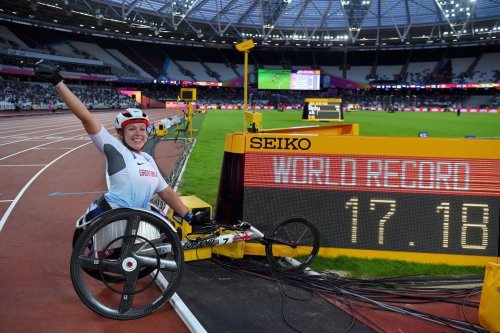 Hannah Cockroft, photo by IPC (2019 World Champs)
Hannah Cockroft, photo by IPC (2019 World Champs)
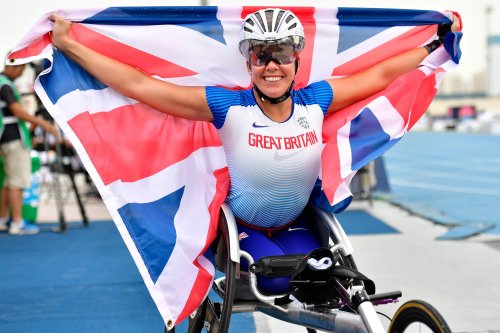 Hannah Cockroft, photo by IPC (2019 World Champs)
Hannah Cockroft, photo by IPC (2019 World Champs)
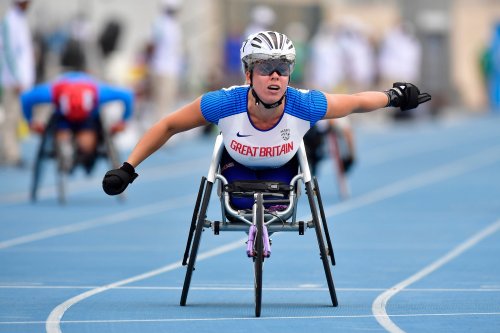 Hannah Cockroft, photo by IPC (2019 World Champs)
Hannah Cockroft, photo by IPC (2019 World Champs)
Hannah Cockroft is a trail blazer in the Paralympics movement. Stuart Weir did a wonderous job on this piece and Hannah Cockroft.
Hannah Cockroft – wheelchair racer
Hannah Cockroft has dominated women’s T34* Wheelchair racing for the past ten years, winning 12 World Championship and five Paralympic gold medals. The length of races has changed over the years. At the 2012 Paralympics there were races at 100m and 200m – as T34 women were not considered capable of racing beyond 200m. In 2015, 400m and 800m events were introduced. By the 2019 World Championships, the program consisted of 100m and 800m only. None of this mattered to Hannah – she won the race, whatever the distance.
I thought I had better begin my interview by asking which was her preferred distance. “I am currently world champion at 100, 200, 400, 800. In Tokyo it will be 100 and 800”, she told me. “Typically, my preferred distance would be 200 and if I could choose two distances, they would be 200 and 400. So, in Tokyo it is the two distances I don’t want to do!”
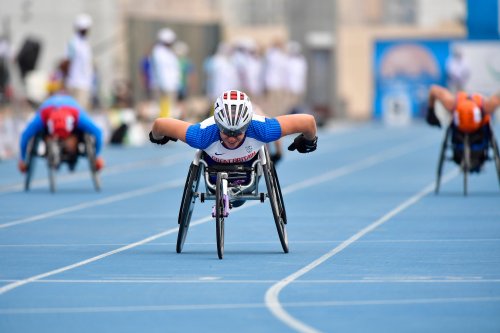 Hannah Cockroft, photo by IPC (2019 World Champs)
Hannah Cockroft, photo by IPC (2019 World Champs)
For a runner, the idea of training for 100m and 800m at the same time would be impossible but it seems to work in wheelchair racing with athletes like Brent Lakatos winning the 100m at the 2019 World Championships and the 2020 London Marathon.
Hannah explained how training for the different distances worked for her: “It is hard and I just have to trust my coach that he knows how to plan my training so that I will get the right preparation for both distances. But it is difficult and sometimes in training I feel I’m leaning towards the 100m and working on that. That makes me panic about the 800m. Sometimes it’s the other way and I am worrying that my 100m will not be very good. It’s been especially hard during lockdown because obviously a 100 meter sprint is easier to do – you only need a 100 meter stretch of road, whereas finding an 800m straight road is more difficult. It is something I worry about a lot but I just have to put my faith in the training program and thankfully it works. One thing I do try to remember is that every race has a sprint in it so even in an 800, my ability to do 100 meter sprint will come in useful. I need to have a strong 100 and anything else is just extra training”.
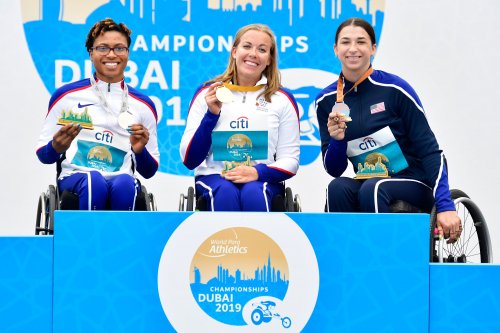 Dubai 2019 , photo by IPC (2019 World Champs)
Dubai 2019 , photo by IPC (2019 World Champs)
Track 800m races are often very tactical, does it work in the same way, I wondered for wheelchair racers: “I go into an 800m with plan A and plan B”, she explained. “I find it very hard to plan tactics because you never know what the other girls are going to do. So I try to prepare for every eventuality. One of the main reasons for moving to Chester was to be able to train with a group of people who are similar speed to me. So normally every time I do an 800m session I have someone who’s faster than me and someone who is slower and someone who is the same speed so you can kind of practice for every eventuality which can occur in a race.
“Plan A for me is always to go to the front as soon as the race starts and stay there. I feel that is always the safest plan. While I race for medals, I also race for times and I want to go quick. You can’t control what other people are doing but you can control yourself. I know that I’m strong enough and tough enough to sit at the front of a race and that I’ve got a good kick, a good sprint, in me. So a lot of it is confidence, knowing what you can and cannot do.
“My two plans are very simple. Plan A is go to the front and stay at the front. Plan B is try to go to the front and if you don’t make it, sit behind someone else. I think tactics are one of my strong points. Women’s races are slow enough that you have time to think about what to do next. The men’s races are ridiculously quick. And the men are more argy bargy than the girls. The women don’t want to get pushed out of their chair. We’re more ‘it’s OK if you go first, I can get round you'”.
Asked further about how wheelchair racers are able to be competitive at such a range, she replied: “We are just weird!” before adding a more serious answer: “For us in the longer events the chair takes part of the strain. Tactics and training are so different in running compared to wheelchair racing. Even if I’m concentrating on the 100, I would train over 800 to make me stronger for the 100m. So I think we’re used to doing distance. Also, there’s not as many ways to train the upper body as there are to train your legs. You do the longer stuff to keep your weight down and keep your muscles strong. I don’t know any racers who just to the short stuff”
In 2018, the unthinkable happened and Hannah was beaten! She had kept a winning streak in T34 races for several years, winning every championship gold medal since 2011. She was beaten in the European Championship 100m and again in a race at the Anniversary Games – on both occasions by Kare Adenegan, also from Britain. Kare, who was only 17 at the time, had finished behind Kare at the 2015 and 2017 World Championships and the 2016 Paralympics. Hannah spoke honestly about the rivalry: “Some days I love it and some days I hate it! I love it because it gives me a reason to train. If I get up in the morning and I don’t want to train, I know I have to. Sometimes when I go training I know that a particular session is purely to beat Kare. I don’t like the feeling it gives me when we line up beside each other in a race. I am quite a confident person and I don’t like how just her presence can knock my confidence.
 Hannah Cockroft, photo by IPC (2019 World Champs)
Hannah Cockroft, photo by IPC (2019 World Champs)
“Ultimately, I like it because it’s good for the sport and it gives people something to write about. It gives people something to watch because we were getting to a point where it wasn’t exciting to watch me race because I was going to win whoever was there. But now Kare adds that – will she won’t she, who’s going to win it? That we are both British, in some senses makes it harder. I think I would like the rivalry more if she wasn’t British. But equally it’s exciting that we have so much talent in Britain and we can show it off. We can be on the podium together and enjoy it. Whether it’s the world championships or a small meet at Stoke Mandeville, we’ve always got that competition. We bring the best out of each other which is fantastic and probably why I’m still getting quicker – because I got someone there to really push it out of me”.
Unfortunately we will have to wait to 2021 for the next big Hannah Kare showdown.
*T34 is one of eight specifically for athletes with cerebral palsy, and one of four for athletes with cerebral palsy who use a wheelchair
Author

Since 2015, Stuart Weir has written for RunBlogRun. He attends about 20 events a year including all most global championships and Diamond Leagues. He enjoys finding the quirky and obscure story.
View all posts


















